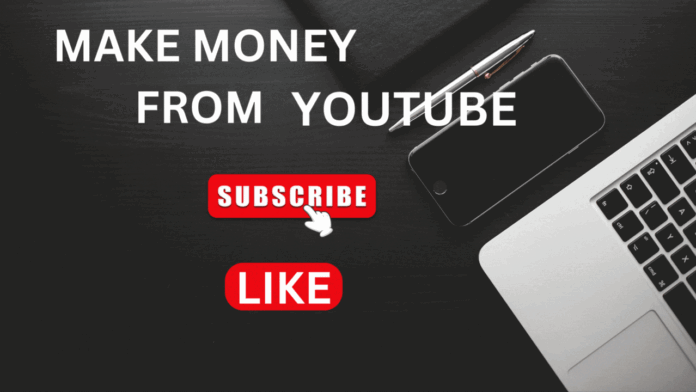Seeking to learn how to manage your YouTube channel?
Due to the large window of opportunity for video revenue. The audience on YouTube is enormous. On the platform, viewers are signing in every day and consuming countless hours of content every week.
Not to mention, in 2023, YouTube is expected to earn an astounding $30.4 billion in ad income.
The problem is that converting views into money doesn’t happen by coincidence. It goes beyond simply advertising your YouTube channel and posting videos. You must have a plan.
For that reason, we penned this explanation of how to get money on YouTube and what to anticipate in the process. In addition to traditional monetization strategies, we’ve included new and creative ways to make money on the site in 2023.
10 genuine methods for making money on YouTube
- 1. Sign up for the Partner Program on YouTube
- 2. Gain subscribers’ support by subscribing to the channel.
- 3. Include affiliate links in the descriptions of your videos.
- 4. Include advertisers in your videos.
- 5. Release videos with a product theme for advertising.
- 6. Make use of affiliate marketing
- 7. Make use of crowdfunding
- 8. Market goods and personalized items
- 9. Turn on YouTube Super Stickers & Super Chat
- 10. Give licenses to outside media businesses for your material
According to recent statistics, YouTube is a creative haven. Yet making money off of YouTube material can be challenging.
For financial gain, creators shouldn’t compromise authenticity or entertainment value.
The favorable tidings? The best or only method to monetize your videos is not defined. Depending on your target market, content, and marketing plan, you have a number of possibilities.
Let’s examine ten methods for earning money on YouTube and how they operate.
1. Sign up for the Partner Program on YouTube
Here, there are no surprises! Creators can make money by having advertisements appear on their videos through the YouTube Partner Program.
Let’s take a brief look at YouTube’s Partner requirements. Assuming you comply with the monetization guidelines of the platform, you require:
More than 4,000 genuine public watch hours in the last 12 months or 10 million legitimate public short views in the last 90 days
More than 1,000 subscribers
a linked and operational Google AdSense account
You’ve probably seen a good number of YouTube advertisements. Ads on YouTube, from pre-roll to in-video, are a rather hands-off method of generating income.
There are too many factors involved to provide a precise estimate of how much money you can generate from advertisements. Among these variables are:
The demographics of your viewers, including age and location
If the ads on your videos are relevant
Your sector and content
YouTube claims that there are “no guarantees” regarding reimbursements or income sharing. The majority of material available is purely anecdotal.
Although “$1 per 1,000 views” was the standard in the past, things have changed. The Partner Program and ad regulations have changed in tandem with the YouTube algorithm. For instance, there are clear guidelines on the platform regarding advertising on YouTube Kids. Videos meant for children are excluded from a number of prominent ad categories and targeting options.
In any case, all you’re looking at is a numbers game. Before you start making any significant money, each video has to receive hundreds or even millions of views.
Unsure whether to run advertisements on your channel? Completely perceptible. Once more, video monetization shouldn’t stop the expansion of your channel.
Your videos become almost unwatchable if they are overflowing with un-skippable commercials. However, a few advertisements here and there are completely acceptable.
2. Gain subscribers’ support by subscribing to the channel.
The purpose of YouTube channel memberships is to assist content creators who want to monetize their work.
Consider subscription services such as Patreon or Twitch. Members receive channel-specific benefits in return for a monthly subscription fee. This could include conversation badges, special content, and other things. These advantages change according to your membership level.
For content creators that use YouTube as their primary channel instead of treating it as a secondary outlet, this feature is especially significant. Memberships are totally reasonable if you post every day or do live streaming on a regular basis. As of right now, channel membership criteria are very similar to partner program eligibility.
3. Include affiliate links in the descriptions of your videos.
A low-hanging fruit on YouTube is to monetize promo links instead of running advertisements.
You have five hundred characters on YouTube to use for your video descriptions, which are important real estate. It makes sense to direct viewers of your YouTube channel to pertinent resources. An author could, for instance, link to:
A lead magnet (such a free course or resource that may be downloaded)
Their website
Their products or online store
An example of how artists can advertise their own goods in a video description can be seen below. Links have the ability to redirect YouTube traffic to your website, if nothing else.
4. Include advertisers in your videos.
Promoted YouTube videos are well-liked by both well-known and emerging content producers.
In your video, you are openly recommending a brand thanks to sponsored material. Usually, a video will have these call-outs at the start and finish. These kinds of advertisements are indispensible since they are a necessary component of your content.
Sometimes, when a sponsored video has no impact whatsoever on the creator, their work, or their viewership, audiences take issue with it. The greatest sponsored films showcase a clever tie-in that doesn’t take away from the original artist’s aesthetic. An excellent illustration is this Beauty Within sponsored video, which showcases the skincare brand.
5. Release videos with a product theme for advertising.
The purpose of branded videos is to specifically advertise a good or service. These videos can be divided into the following categories:
In return for the creator’s material or review, a brand pays them.
The creator has received instructions and talking points from the brand (consider influencer or brand ambassador material).
Making a video to promote a brand and get affiliate income is the creator’s goal.
Beauty and skincare firms frequently use these kinds of films, in which the producers open PR presents live on camera.
6. Make use of affiliate marketing
The main goal of affiliate marketing is to use your influence to promote other products and increase sales. As a content producer, you can collaborate with businesses to include their goods or services in your work.
Here, the concept is straightforward. In your films, you talk about things and then give viewers an easy method to check them out.
You receive a commission each time a viewer clicks on your link and purchases something. Both brands benefit from increased awareness and sales, and you receive a portion of the earnings.
This strategy is very well-liked by reviewers and content producers that produce “how-to” videos.
The important thing to note is that the video’s subject matter extends beyond the products themselves. While some content authors mention their affiliate links, others do not. You have the option!
Note: YouTube’s TOS are not violated by affiliate links, which are completely allowed. The platform does, however, have a clear external link policy. It is advisable to go over YouTube’s rules before including links in your videos.
7. Make use of crowdfunding
Using crowdfunding to finance your content creation and encourage collaboration is an excellent idea. It’s similar to getting support for your next major project from your followers.
Your supporters can pay a monthly fee on platforms like Patreon in exchange for special material and benefits like BTS footage, shout outs, or first access to new films.
For instance, there are three Patreon subscription tiers available for the cooking channel Made with Lau:
In the descriptions of each video, they also make sure to provide a link to their Patreon page.
If you want to raise money for your creative endeavors, you can also check into other crowdfunding websites like Indiegogo and Kickstarter.
Just remember to provide your audience with a link, and always keep your word.
8. Market goods and personalized items
It makes sense to sell branded products on YouTube in order to increase revenue, improve exposure, and strengthen bonds with your fan base.
However, if you already have a devoted fan base that is prepared to pay for your merchandise, this kind of social shopping will work best for you.
You might sell personalized t-shirts, hoodies, mugs, caps, or artwork, depending on your niche. Have a joke up your sleeve? A slogan? A mark? Make original designs with it for your supporters. You can also hire freelance designers on Fiverr or use Canva to create your own creative designs to hand over to suppliers.
9. Turn on YouTube Super Stickers & Super Chat
Thanks to Super Chat & Stickers, you can interact with your audience directly on YouTube and get compensated for it, which is a wonderful feature.
This is how it operates.
Viewers can pay to have their messages highlighted in the conversation during a live stream. In a live conversation, they can also send Super Stickers, which are animated graphics that cost money.
If you host regular live sessions, Super Chats and Stickers are a fantastic way to boost YouTube engagement, earn extra revenue and make your audience feel warm and fuzzy inside.
Turn on Super Chat by heading over to your monetization settings. Make sure you thank and appreciate viewers who support your channel and pay to get your attention.
10. Give licenses to outside media businesses for your material
If you chance to make something unusual or noteworthy, like a viral video, other platforms or media outlets might be interested in featuring it.
They can utilize your content, but only if they get a license.
It allows you to monetize previously produced material and expand its audience beyond your channel.
proactively contact media outlets or take your time for them to get in touch with you. On the other hand, submit your content to Junkin Media, where news websites and TV networks can find and purchase it.
Consistent work and focused effort are necessary to generate any kind of revenue from YouTube.
However, a huge number of creators are achieving success with their work. There are many ways to make money off of your movies, including sponsorships, ads, and crowdfunding. With any luck, these pointers will enable you to identify a path that makes sense!
Found this article interesting? Follow BG on Facebook, Twitter and Instagram to read more exclusive content we post.

